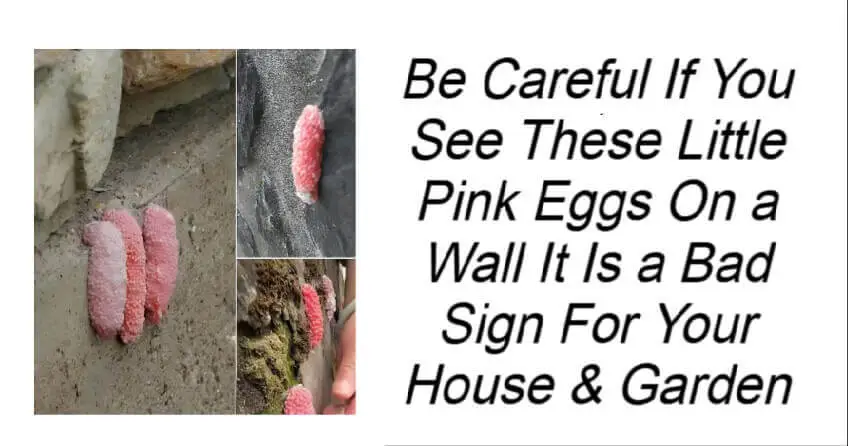Be Careful If You See These Little Pink Eggs On a Wall It Is a Bad Sign For Your House & Garden
If you’ve ever stumbled upon clusters of small, bright pink eggs in your garden, they may seem harmless—or even festive. But don’t be fooled! These eggs belong to the invasive apple snail, a species that poses a serious threat to local ecosystems. Originally from South America, apple snails have spread worldwide, wreaking havoc on plants, crops, and natural habitats.
The Apple Snail: A Giant Among Freshwater Snails
Apple snails are much larger than the typical garden snail, with shells reaching up to 10 centimeters (4 inches) wide. They thrive in wet environments such as ponds, lakes, and swamps, spreading rapidly—especially in warmer climates.
One of their most distinctive traits is their pink or orange egg clusters, which contain anywhere from 400 to 600 eggs. This rapid reproduction makes them one of the most successful and destructive invasive species.
Why Are Apple Snails So Invasive?
Apple snails rank among the world’s top 100 most invasive exotic species, thanks to their ability to adapt, reproduce, and dominate in new environments. Initially confined to South America, they have now spread across North America, Europe, and Asia, aided in part by rising global temperatures.
These snails don’t just survive in new habitats—they take over. Voracious eaters, they consume a wide range of plants, often outcompeting native species. In Southeast Asia, where they were introduced in the 1980s, apple snails have devastated rice fields, causing severe agricultural losses. Their rapid spread and unchecked appetite threaten both biodiversity and food production.
The Tell-Tale Sign of an Invasion
The bright pink egg clusters laid by apple snails are a key warning sign of their presence. These eggs are typically found on leaves, branches, or other elevated surfaces near water, ensuring their survival. Their vivid color acts as a natural warning to predators, as the eggs contain toxins that make them unappealing.
If you spot these eggs, act fast! Each cluster can hatch hundreds of snails, which will quickly spread and cause damage. Many countries encourage residents to report sightings of apple snail eggs to help control their population.
Where Have Apple Snails Spread, and What Damage Do They Cause?
Apple snails have now established themselves in Florida, Texas, and California in the U.S., as well as parts of Asia and Europe. In 2018, apple snail eggs were discovered in France near Fréjus, sparking containment efforts—but even these weren’t enough to stop their spread.
How They Harm the Environment:
- Destroy Aquatic Plants – Apple snails consume vegetation that supports fish, insects, and other wildlife.
- Worsen Water Quality – By stripping ecosystems of plants, they disrupt oxygen levels and pollute waterways.
- Damage Crops – In agricultural areas, they feed on young rice shoots, leading to financial losses for farmers.
- Threaten Native Species – Their rapid reproduction allows them to outcompete local snails and other freshwater species.
How to Control Apple Snails
Due to their fast reproduction and resilience, controlling apple snails requires a coordinated effort:
🔹 Report Sightings – Many countries have hotlines or websites for reporting apple snail eggs. Early detection is key!
🔹 Manual Removal – If you find pink egg clusters, scrape them off surfaces and dispose of them properly. Always wear gloves, as the eggs may contain toxins.
🔹 Biological Controls – Researchers are studying natural predators or parasites that could help keep apple snail populations in check. However, these solutions are still being tested to prevent unintended consequences.
🔹 Public Awareness – Many people unintentionally contribute to the spread of apple snails by releasing them from aquariums. Educating communities about the risks of invasive species is crucial.
Why Apple Snail Invasions Should Concern Gardeners
If you have a garden with ponds or water features, these invasive snails can quickly destroy your plants. Their pink eggs aren’t just an eyesore—they signal a much larger ecological threat.
Once apple snails establish themselves, they can be extremely difficult to eliminate. Acting fast when you spot their eggs can help protect your garden, local wildlife, and the broader ecosystem.
Conclusion
Spotting pink eggs in your garden may be startling, but recognizing them as a warning sign can help you take swift action. Apple snails are more than just a nuisance—they threaten biodiversity, agriculture, and freshwater ecosystems worldwide.
By staying informed, reporting sightings, and removing eggs, you can help slow their spread and protect your environment. Every effort counts in preserving natural ecosystems—one pink egg cluster at a time.
You’ve just read, Be Careful If You See These Little Pink Eggs. Why not read Manager Had To Hire A New Employee.

